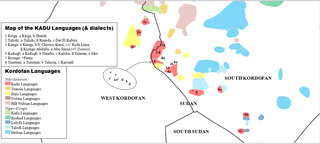
The Kordofanian languages are a geographic grouping of five language groups spoken in the Nuba Mountains of the South Kordofan region of Sudan: Talodi–Heiban languages, Lafofa languages, Rashad languages, Katla languages and Kadu languages. The first four groups are sometimes regarded as branches of the hypothetical Niger–Congo family, whereas Kadu is now widely seen as a branch of the proposed Nilo-Saharan family.

Niger–Congo is a hypothetical language family spoken over the majority of sub-Saharan Africa. It unites the Mande languages, the Atlantic-Congo languages, and possibly several smaller groups of languages that are difficult to classify. If valid, Niger-Congo would be the world's largest in terms of member languages, the third-largest in terms of speakers, and Africa's largest in terms of geographical area. It is generally considered to be the world's largest language family in terms of the number of distinct languages, just ahead of Austronesian, although this is complicated by the ambiguity about what constitutes a distinct language; the number of named Niger–Congo languages listed by Ethnologue is 1,540.

The Nilo-Saharan languages are a proposed family of African languages spoken by somewhere around 70 million speakers, mainly in the upper parts of the Chari and Nile rivers, including historic Nubia, north of where the two tributaries of the Nile meet. The languages extend through 17 nations in the northern half of Africa: from Algeria to Benin in the west; from Libya to the Democratic Republic of the Congo in the centre; and from Egypt to Tanzania in the east.

The West Atlantic languages of West Africa are a major subgroup of the Niger–Congo languages.

Benue–Congo is a major branch of the Volta-Congo languages which covers most of Sub-Saharan Africa.

The Mande languages are a group of languages spoken in several countries in West Africa by the Mandé peoples. These include; Maninka, Mandinka, Soninke, Bambara, Kpelle, Jula, Bozo, Mende, Susu, and Vai. There are around 60 to 75 languages spoken by 30 to 40 million people, chiefly in; Burkina Faso, Mali, Senegal, the Gambia, Guinea, Guinea-Bissau, Sierra Leone, Liberia, Ivory Coast, Mauritania, Ghana and also in northwestern Nigeria and northern Benin.
The Adamawa languages are a putative family of 80–90 languages scattered across the Adamawa Plateau in Central Africa, in northern Cameroon, north-western Central African Republic, southern Chad, and eastern Nigeria, spoken altogether by only one and a half million people. Joseph Greenberg classified them as one branch of the Adamawa–Ubangi family of Niger–Congo languages. They are among the least studied languages in Africa, and include many endangered languages; by far the largest is Mumuye, with 400,000 speakers. A couple of unclassified languages—notably Laal and Jalaa—are found along the fringes of the Adamawa area.

The Atlantic–Congo languages are the largest demonstrated family of languages in Africa. They have characteristic noun class systems and form the core of the Niger–Congo family hypothesis. They comprise all of Niger–Congo apart from Mande, Dogon, Ijoid, Siamou, Kru, the Katla and Rashad languages, and perhaps some or all of the Ubangian languages. Hans Günther Mukarovsky's "Western Nigritic" corresponded roughly to modern Atlantic–Congo.
Ijoid is a proposed but undemonstrated group of languages linking the Ijaw languages (Ịjọ) with the endangered Defaka language. The similarities, however, may be due to Ijaw influence on Defaka.

The Kadu languages, also known as Kadugli–Krongo or Tumtum, are a small language family of the Kordofanian geographic grouping, once included in Niger–Congo. However, since Thilo Schadeberg (1981), Kadu is widely seen as Nilo-Saharan. Evidence for a Niger-Congo affiliation is rejected, and a Nilo-Saharan relationship is controversial. A conservative classification would treat the Kadu languages as an independent family.

The Temein languages, or Nuba Hills languages, are a group of Eastern Sudanic languages spoken in the Nuba Mountains of Sudan.
The Katla languages are two to three closely related languages that form a small language family in the Nuba Hills of Sudan. Part of an erstwhile Kordofanian proposal, they are of uncertain position within the hypothetical Niger–Congo family. They do not share the characteristic morphology of Niger–Congo, such as the noun-class system. Thus Roger Blench classifies them as a divergent branch of Niger–Congo outside the Atlantic–Congo core. A similar situation holds for another Kordofanian family, Rashad; these are not closely related to Katla.

The Talodi–Heiban languages are a proposed branch of the hypothetical Niger–Congo family, spoken in the Nuba Mountains of Sudan. The Talodi and Heiban languages are thought to be distantly related by Dimmendaal, though Glottolog 4.4 does not accept the unity of Talodi–Heiban pending further evidence.
Lumun (Lomon), also Kuku-Lumun, is a Niger–Congo language in the Talodi family spoken in the Nuba Mountains, Sudan.

Tegali is a Kordofanian language in the Rashad family, which is thought by some to belong to the hypothetical Niger–Congo phylum. It is spoken in South Kordofan state, Sudan.
Lafofa, also Tegem–Amira, is a dialect cluster spoken in the southern Nuba Mountains in the south of Sudan. Blench (2010) considers the Tegem and Amira varieties to be distinct languages; as Lafofa is poorly attested, there may be others.
Tocho (Tacho) is a Niger–Congo language in the Talodi family spoken in Kordofan, Sudan. It is spoken by approximately 2,700 people in the following villages: Igije, Imanjela, Thodero, Thoge, Tobaredeng, Tocho Goos, Tocho Saraf Jamus, Toderum, Togero, Togiding, Toriya, Torobang, Tothokrek and Turu.
Acheron (Asheron) is a Niger–Congo language in the Talodi family spoken in South Kordofan, Sudan.

The Nuba Mountains, located in the West Kordofan and South Kordofan states in the south of Sudan, are inhabited by a diverse set of populations speaking various languages not closely related to one another.
Proto-Niger–Congo is the hypothetical reconstructed proto-language of the proposed Niger–Congo language family.











